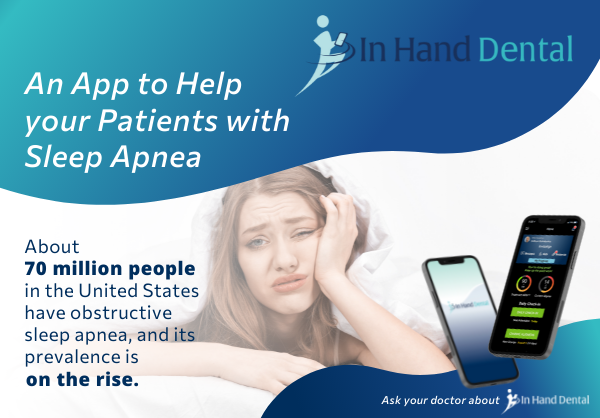Were you aware that, in 2017, a resolution was passed by the ADA emphasizing the role of all dentists in screening for sleep disordered breathing? It was part of your training in dental school, and it’s time you made the most of your oral appliance therapy expertise.
Each time you see a patient, your protocol should include screening for symptoms such as weakened teeth, scalloped tongue, and redness in the throat, as well as non-dental symptoms such as excessive daytime sleepiness and mouth breathing. These can all be symptoms associated with sleep apnea. It’s also important to make a chart note if a patient has a smaller jaw and/or is prone to clenching. But there’s something else you can do that’s even more proactive: introduce that patient to the In Hand Dental app (IHD).
The 2017 ADA resolution stated that dentists can offer oral appliance therapy to patients suffering from mild to moderate sleep apnea (especially helpful when a patient can or won’t use a CPAP machine).
It’s also an opportunity to show your patient how using the IHD app will allow you to remotely monitor how their oral appliance therapy is working, and also set up real-time, ongoing communications between you and your sleep apnea patient.
How to Add Sleep Apnea Care to Your Practice
As noted in the ADA 2017 report, “dentists have an important role in identifying patients with Obstructive Sleep Apnea (OSA). As part of routine dental examinations, dentists can recognize a small upper airway and other anatomic risk factors for OSA and use the opportunity to identify potential patients through use of simple screening questions and/or questionnaires. This can help reduce the problem of under-diagnosis of OSA.”
That said, in addition to conducting oral examinations that screen for the symptoms mentioned above, it’s suggested that dentists ask all patients to complete a simple questionnaire about their sleep habits and lifestyle. Here are some questions to consider for your questionnaire:
- Are you under a physician’s care now?
- Have you ever been hospitalized or had a major operation?
- Are you taking any medications, pills, or drugs?
- Do you use tobacco (including e-cigs). If so, what do you use?
- Do you use controlled substances? If so, what do you use?
- Do you consume alcohol? If so, how often each week?
- Do you snore/have you been told you snore?
- Have you ever done a sleep study or told you needed one?
- Do you currently wear a C-PAP device or told you needed one?
Another Important Step: Partner with a Qualified Sleep Physician
As a dentist qualified to assist in the treatment of sleep disordered breathing, it’s important to build a collaborative relationship with a sleep physician in order to give your patient full expert attention and ensure a safe, effective outcome.
A sleep physician should confirm the OSA diagnosis and may recommend Oral Appliance Therapy (OAT). You as the dentist should confirm that OAT is in fact appropriate and then initiate that therapy. In-office follow-ups should be done by both your office and the sleep physician.
Every Sleep Apnea Patient Needs the In Hand Dental App
Once diagnosed and under treatment with an OAT, the In Hand Dental app shines by giving you the ability to easily integrate 24/7 remote monitoring with your patient when it comes to one, ensuring they are being compliant with using their OAT; and two, providing a simple, familiar way to maintain an open line of communication with you.
Need more good reasons to hop on the In Hand Dental app bandwagon? Schedule a free private demo today by calling In Hand Dental at (913) 701-7444 or completing the online request form.

